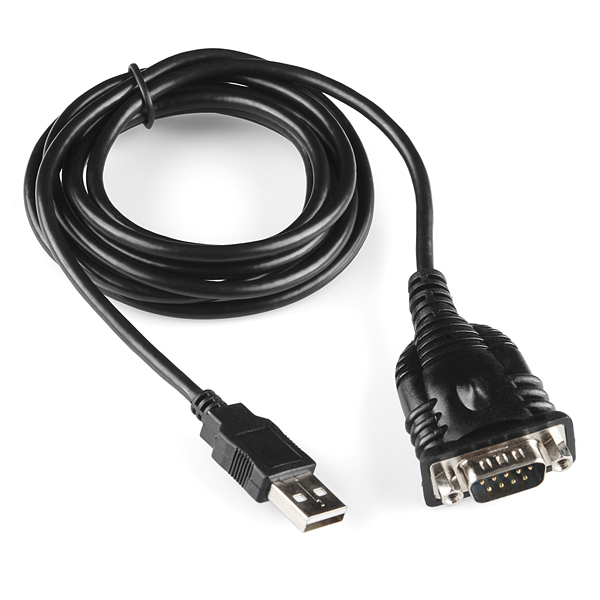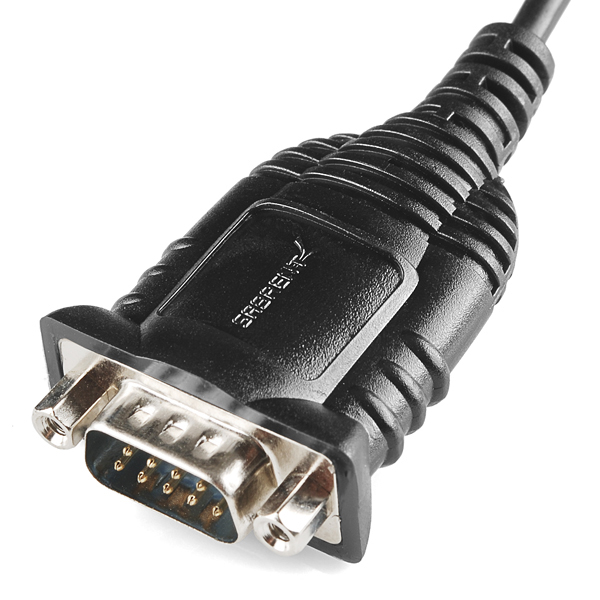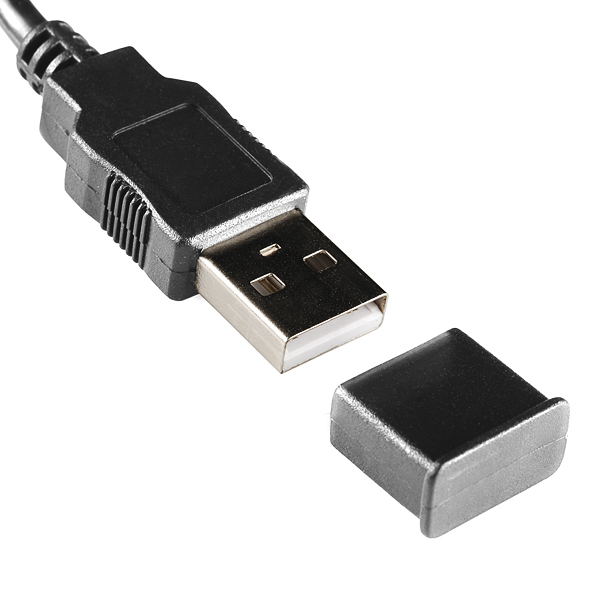There are a lot of devices out there that still communicate over RS232 but we bet your new laptop isn't one of them. Don't worry, though, we've got you covered. This 6ft converter plugs into your computer's USB port and provides you with a DB-9 RSR232 connection. After installing the drivers onto your Windows, Mac or RedHat Linux system, the FTDI chipset inside the cable will enumerate as a COM port with a baud rate adjustable to whatever setup you want to connect to.
We were curious what made this cable work, so we tore one open and found that it's simply an FTDI FT232 paired with a Zywyn ZT213 RS232 Transceiver. You can find the datasheets for those devices below as well as a link to the FTDI driver page. We've also uploaded a copy of the included drivers CD in zip format.
If you're still trying to wrap your head around the world of USB cables, why not check out our USB Buying Guide?
Replaces: CAB-10270
- USB to RS232 Converter Cable
- Driver CD
- Datasheet (ZT213LE)
- Datasheet (FT232RL)
- FTDI Drivers
- Drivers CD ZIP
USB to RS232 Converter - 6ft Product Help and Resources
Connector Basics
January 18, 2013
Connectors are a major source of confusion for people just beginning electronics. The number of different options, terms, and names of connectors can make selecting one, or finding the one you need, daunting. This article will help you get a jump on the world of connectors.
Comments
Looking for answers to technical questions?
We welcome your comments and suggestions below. However, if you are looking for solutions to technical questions please see our Technical Assistance page.
Customer Reviews
4.6 out of 5
Based on 7 ratings:
Great Value
Worked great right off. No problems.
four
Nicely replaces a unit whose driver support ended with OS/X Yosemite and Windows 7.
Works with Windows 10
This converter uses the FTDI chipset on the COMM port side which has been recommended by serial equipment manufacturers. The Zywyn ZT213 RS232 transceiver on the other end is likewise recommended. The software package does not include Windows 10, however the Windows 8 software does work with my Windows 10 laptop.
USB to RS232 Converter - 6ft works…
Using it to control my Ham radio (Ten-Tec Omni VI Plus) with my PC. Using the program WSJT-X. working fine :-)
0 of 1 found this helpful:
USB TO RS232 Converter
Still waiting for the inspection report so unable to comments on the performance and working. But the Packing and Delivery was Superb and 5 star rating.
Great for communications with old machines
This cord is the second that I have purchased to take with me as I travel working on CNC machines. I have always been able to communicate with the old boards that I have needed to (almost always Fagor controllers or drives). It is a nice size and length to travel with and gets the job done.
Works as expected
I have only used it in the three wire mode (gnd, Tx, and Rx) and it works well in that mode. I would buy another one.




Will this work in the cold, the datasheets for the chips say -40c, is that true for the hole adapter? We have been having trouble with a similar device on a telescope that can be exposed to -20 f indoors and are looking for a replacement.
VCC pin?
I've noticed that some products like this don't connect all the flow control signals (RTS, CTS, DCD, etc.) but instead only connect RX, TX, and ground on the serial side. Does this cable support full hardware flow control?
I would also like to know this. My mom has an embroidery machine that uses a serial device to write to its memory card. So far none of the cheap-o USB-Serial adapters have worked and I think it is due to lack of hardware flow control. More info or a datasheet would be greatly appreciated.
I'd wager this will not support hardware flow control. I've bought about 10 different kinds off ebay so far, several look the same as this, and none of them stop sending when my plotter buffer is full (unlike my physical serial port in my old PC, which does work fine).
Hi But we have developed a new Universal usb to serial adapter,which are totally different and in chief range. i.e USB to UART-TTL/RS232/RS485/SDI , easy to use adaptor
For further information Plz visit our site www.itagesolutions.com
Can I use this with Arduino IDE to program a ATMega 328 tqfp?
This device was configured automatically by my Win7 computer. Great!
BUT: The DB-9M should have two screws to firmly attach the plug to the serial device (radio reciever). Instead, I found two female nuts STAKED to the connector. Being STAKED, they cannot be un-screwed to allow the connector to mate with the reciever serial port. This device is a waste of good money. I was able to remove the nuts, but this also removed the "D" shaped frame from the connector. It was barely usable and will surely be rendered un-usable once removed from the reciever.
I have used several USB-Serial adapters from SPARKFUN over the past several years, and was very happy with them. Not this time. I have never seen a cable with the attachment nuts STAKED to the frame. IMHO, this is a sign of cheaply made merchandise.
...bill
Bill -
Think of this as a plug in serial card for your desktop rather than a cable. Female screw connectors are standard for DTE/DCE. I use a number of different cables ( some with HW flow control, others w/o) thus would caution calling for a nonstandard fastener on the port. (BTW I've looked at half a dozen of these USB-RS232 adapters and all of them present as standard DTE)
Hope this helps!
I concur. The plug, as is, is just like a standard 9 pin male DTE serial port that you used to find on a PC - including the nuts.
Sorry to hear you were so dissatisfied with this product.We'll take a look into this, as this is the first complaint I personally have heard about this issue.
Just out of curiosity, how long is the cable? 6ft?
Has anyone tried one of these on Windows 8 yet?
I have just found that a different adaptor (Prolific chip set) which worked happily on Win XP won't work with my new computer. It seems that Prolific are not supporting older chip sets with drivers for Windows 8, and there is the issue of counterfeit Prolific chips but how would you know, particularly when the device cost over $40 from a major shop chain here in Australia.
If you're looking for a chip with all the 9 pins connected, I know from experience the ones from ATEN do this. They are based on prolific though, but they are original chips with all 9 pins connected to RS232. Not sure about this one thought but given the price I would expect it to have all the 9 pins connected too.
For some reason, it is increasingly difficult to find reliable USB to Serial adapters. There are so many counterfeits out there (especially with prolific chips) that it's hard to find a decent one.
just a quick heads up: according to Prolific many of the chips currently on the market don't seem to be compatible with the upcoming win8; apparently only the PL2303->Rev D is compatible. I am assuming with FTDI this won't be an issue.
Cypress introduced a new single-chip low power USB-UART Bridge solution, this week. This one has all flow control signals and TX-RX LEDs. It looks like no external components required. It is ready to go with all drivers.
Hope to see a Sparkfun breakout board for this one soon.
Site: http://www.cypress.com/?id=4143
News: http://www.interconnectionworld.com/index/display/wire-news-display/1684808414.html
Why would someone pay $15 for this (probably made in China) when Ebay sells those for no more than $2 (also made in China)?
Just asking...
Edit: sorry, it was no more than $3
Because that $3 adapter will not work with a Basic Stamp. I'm not sure if this one does either though. Sparkfun? You guys want to test that for us? BS2s aren't used by as many people anymore (and good riddance to BASIC, I'll take my C++ Arduinos and variants over that any day), but they are a great test of serial adapters due to their handshaking requirements.
A lot of the cheap ones use counterfeit Prolific serial chips that Windows 7 doesn't like. I have one and it's not good at all for high-speed applications. My genuine Prolific and FTDI cable work marvelously, though.
Basically, you're paying for genuine chips and superb build quality.
I've been using the SF BOB-00718 USB to Serial boards with a FTDI chip as I don't want RS-232, but simply TTL serial data. It gives access to all of the flow control signals, the boards have been used for all kinds of things and have always worked great except for PIC ICP & ICD using MCS (MicroCode Studio) software. The FTDI DTR line has always worked properly with other software, but MCS obviously uses some code that requires a native RS-232 port and hard to know if other programing software has used similar code, or not, so no guarantee USB ports will work in every case. Anyway, if anyone else is using MCS and looking for a solution, other than using an old PC with a "real" serial port, a PCI express RS232 adapter card worked for me, but I would still prefer to be able to use my SF USB to serial boards so please speak up if anyone knows some magic setting that will fix the problem (or how to convince MCS that it needs to fix their software).
nod I was pretty sure the FTDI chip provides all the needed signals (in TTL format), but it's up to the hardware (meaning the individual manufacturer) to make sure that the "right" connections and level conversions are provided to get those signals properly connected to the serial port side. I can imagine that it might save some money to skip the hardware needed to wire out all the flow control lines. I'm curious if this specific product has full HW flow control (which might or might not be true even if the FTDI chip supports it).
Looking at the pictures closely, I can just about make out the word "SABRENT" on the cable. Sabrent does indeed make an FTDI-based USB-to-serial cable (model # SBT-FTDI), but the manual on their website refers to their Prolific-based product, so it may or may not apply.
I hope it DOES have the DTR connected at least. That will let it be used for Arduino programming with older and home brew Arduino's that are serial based, not USB based.
I'd be more than happy to take that bet... C'mon, a hardware geek that buys a laptop WITHOUT a serialport?!
Still keep my Pentium 3 - XP - Vaio - with DB9 AND DB25 ports,USB1 - 10 year old laptop just for PIC programing...
Edit: I still appreciate this cable though...my new laptop (Optimus Prime's lost child) indeed does not enjoy the awesomeness of 232.
Topped you for vintage, I have a 1998 IBM thinkpad 380Z pentium II Running at a Whopping 300mhz just for some educational stuff and it still runs XP fine (standard win2000 went kaput). This is the only computer I own that has a serial port.
It's not quite as old, but I have a Thinkpad 600E PII that I used to use. Windows 2000 actually managed to use the (single) USB port properly too! I was using a 600X (PIII, massive upgrade, and WinXP!) until recently as my programming laptop.
I have a Parallax USB-Serial adapter now that I use with my Z61t (upgraded to a T7200 Core 2 @ 2Ghz). Yeah, I don't miss the old ones at all.